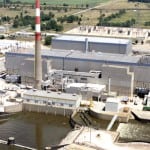The U.S. Supreme Court’s refusal to reconsider industry-led challenges to state nuclear subsidy programs in New York and Illinois leaves the contentious matter to the Federal Energy Regulatory Commission (FERC).
The high court on April 15 declined to accept petitions for review of decisions by the Second Circuit and Seventh Circuit, dealing a major blow to members of the Electric Power Supply Association (EPSA). The trade group—which represents independent power producers and marketers that participate in competitive markets, including NRG Energy, Vistra Energy, and Calpine—has for several years decried state measures to prop up uneconomic nuclear plants, claiming they interfere with FERC’s jurisdiction over wholesale electric rates and unlawfully interfere with interstate commerce.
The Supreme Court’s decision on Monday is the latest in the series of significant legal losses, though EPSA has consistently noted in arguments that the high court unanimously ruled in April 2016 (Hughes v. Talen Energy Marketing) that state subsidies to power generators are pre-empted by the Federal Power Act if they are tethered to FERC-regulated wholesale power prices, New York’s Public Service Commission revised the recommendation in July 2016 and based the subsidy’s formula on an estimated “social cost of carbon.”
EPSA’s challenges to state measures have been stricken by multiple courts since October 2016, when the group filed a federal lawsuit challenging New York’s incentive program to help three nuclear plants—R.E. Ginna in Ontario, Nine Mile Point in Oswego, and FitzPatrick in Scriba—remain economic over the next decade. In February 2017, the group also challenged Illinois’ zero-emission credit (ZEC) program within its December 2016-enacted Future Energy Jobs Act to keep Exelon Corp.’s Clinton and Quad Cities plants open.
In July 2017, however, the U.S. District Court for the Northern District of Illinois let stand Illinois’ ZEC program, ruling in favor of motions by the state and Exelon. That month, U.S. District Judge Valerie Caproni in Manhattan also dismissed challenges against New York’s Clean Energy Standard nuclear subsidies, ruling that federal law does not preempt the state and its Public Service Commission from using a ZEC program. And while EPSA appealed those cases—the New York case in the Second Circuit, and the Illinois case in the Seventh Circuit—the Department of Justice and FERC entered the fray in May 2018, arguing in a brief filed with the Seventh Circuit that the Illinois program was not preempted. The Seventh Circuit’s final judgment affirming the Illinois ZEC program came quickly afterward in September 2018. The Second Circuit followed suit that same month, making clear that tethering between state programs subsidizing certain nuclear units and federal regulation of wholesale rates received by those units is only unlawful if it ties to market participation, not market prices. The EPSA, not willing to give up the fight, sought the Supreme Court’s review in October.
Focus Shifts Back to FERC
As EPSA President and CEO John Shelk said in a statement on April 15, the group “regrets” the Supreme Court’s decision not to grant its petitions to review the appeals. He said, “The focus now shifts back to the Federal Energy Regulatory Commission.”
EPSA has been closely watching how FERC will proceed on two new approaches that PJM Interconnection filed recently to reform its capacity market in response to the energy regulator’s June 29 order on the grid operator’s Minimum Offer Price Rule (MOPR). In that order, FERC rejected two approaches to revamp the MOPR in a 3–2 decision—but it agreed that the capacity market’s integrity and effectiveness has been increasingly and “untenably threatened” by state subsidies for preferred generation resources. While the commission’s majority determined that the existing MOPR renders the grid operator’s tariff “unjust and unreasonable,” it left the issue unresolved.
But though FERC had said it could issue an order before Jan. 4, 2019, it has yet to rule on the new plan—and PJM last week acknowledged FERC has no deadline to do so. PJM has underscored the issue’s urgency as more states in its 13-state footprint consider providing more support based on an “ever-widening scope of justifications.” These subsidies have a “suppressive effect” on the price of capacity procured by PJM through its capacity market, which is known as the Reliability Pricing Model (RPM), PJM acknowledges.
Last week, PJM confirmed it would delay its next base residual auction (for the 2022–23 delivery year) from May to Aug. 14, 2019, but it said it would hold the auction under current rules owing to FERC’s inaction. In a filing, however, the grid entity asked FERC to clarify it would not invalidate the results of the auction with an order that would require PJM to rerun the auction.
According to EPSA’s Shelk, FERC’s June 29 order makes clear that state subsidies for nuclear and other sources impair the integrity of PJM’s wholesale market. “That is hardly what FERC told the [Seventh Circuit] it would do to protect markets,” he said.
“The problem has only gotten worse since the June 29, 2018 order, with emboldened nuclear subsidy seekers now pounding on the doors of state legislatures in Ohio, Pennsylvania and again in Illinois for a second helping,” Shelk said. “FERC told the appeals court the solution lies with FERC; the time for FERC to live up to that promise is now.”
The Widening ZEC Horizon
Another reason the Supreme Court’s decision is so significant is that it shows the New York and Illinois nuclear subsidy programs are legally resilient. They “provide an example of how states can craft a generator subsidy program that will survive judicial challenge,” said Jennifer Mersing, of counsel at Stoel Rives’ Energy and Regulatory group, whose practice focuses on electric regulatory issues.
“Under the Second Circuit’s and the Seventh Circuit’s narrow reading of the Supreme Court’s decision in Hughes, states would be allowed to subsidize generation of their choosing, as long as the selected subsidy program only has an indirect (even if expected) impact on wholesale power market,” she noted. “But, FERC still has the authority to change wholesale market power rules to mitigate the market effect of state generation subsidy programs.”
For Exelon, the Supreme Court’s decision is a win, and not just for the company’s bottom line. “Today our nation’s highest court let stand two appellate court decisions affirming that states have a right to protect their citizens by favoring clean energy—including nuclear—over pollution-emitting energy from coal, oil and natural gas power plants, “ it said in a statement on Monday. “This decision is a win for consumers, policymakers and regulators in states that choose to support the continued operation of nuclear plants as part of efforts to reduce carbon emissions and address the effects of climate change.”
ZEC programs, which are designed to promote and preserve low-carbon generation, are backed by multiple states, it noted. Along with Illinois, New York, and New Jersey, in 2017, Connecticut also enacted legislation to allow Dominion’s Millstone nuclear plant to become eligible for a state procurement process for ZECs, upon certification of financial need.
And in 2018, New Jersey enacted zero-emission credits (ZECs) to bolster profitability of the Hope Creek plant, which is owned by PSEG, and Salem, whose output Exelon owns jointly with PSEG. However, those plants still need to be deemed eligible for ZECs by the New Jersey’s Board of Public Utilities (NJBPU). NJBPU approved a ZEC program and application process for nuclear plants in November 2018, and it is expected to make a final determination regarding the eligibility of PSEG’s plants on April 18.
Last week, Ohio’s lawmakers announced a plan to provide financial support to keep FirstEnergy Solution’s (FES’s) Davis-Besse and Perry plants open. Meanwhile, Pennsylvania’s lawmakers have begun debates about subsidizing its its five nuclear power plants, which are separately owned by Exelon, Talen Energy, and FES. Bills to subsidize power from the plants have now been introduced in the House as well as in the Senate. In a hearing on Friday, lawmakers reportedly questioned Exelon about the profitability of its nuclear fleet.
—Sonal Patel is a POWER associate editor (@sonalcpatel, @POWERmagazine).










